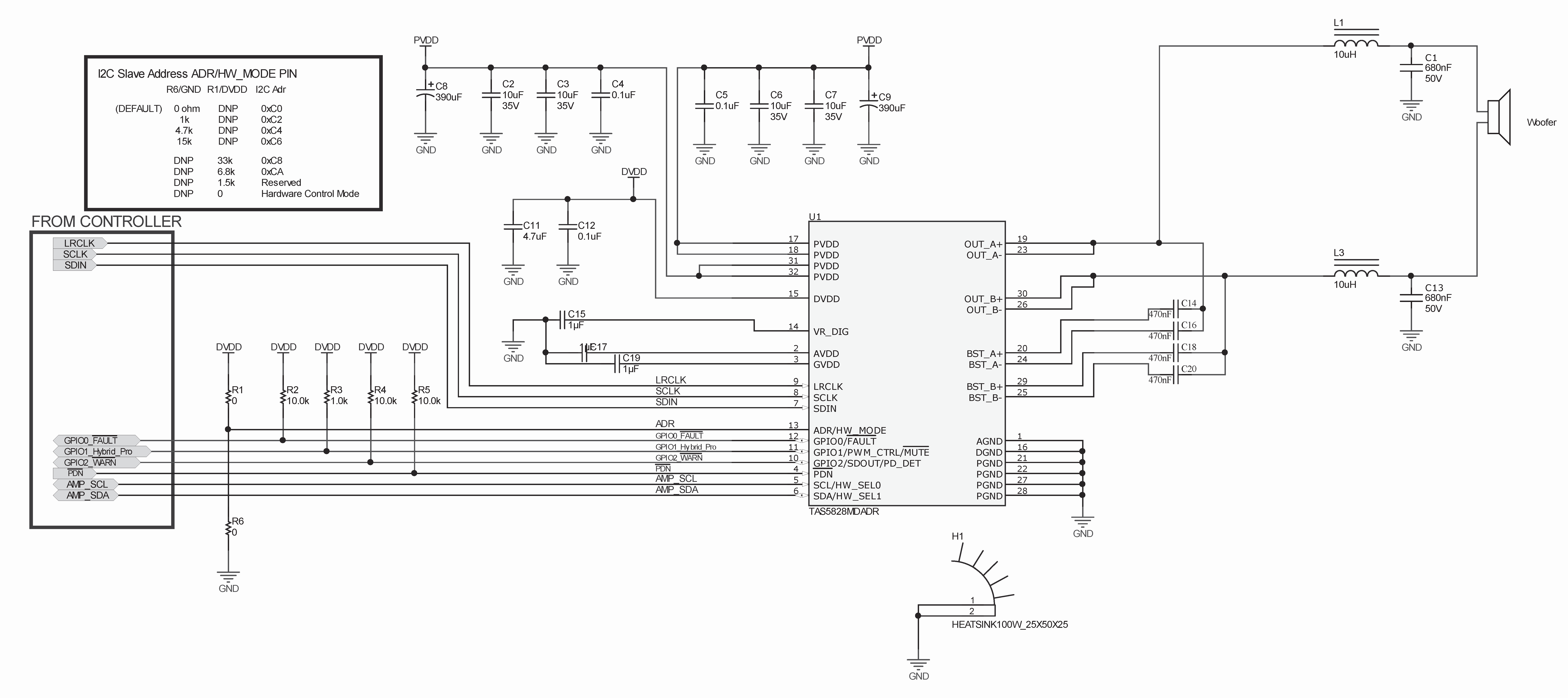ZHCSO77A June 2021 – December 2021 TAS5828M
PRODUCTION DATA
- 1 特性
- 2 应用
- 3 说明
- 4 Revision History
- 5 Pin Configuration and Functions
- 6 Specifications
- 7 Parameter Measurement Information
-
8 Detailed Description
- 8.1 Overview
- 8.2 Functional Block Diagram
- 8.3 Feature Description
- 8.4 Device Functional Modes
- 8.5 Programming and Control
- 8.6 Register Maps
- 9 Application and Implementation
- 10Power Supply Recommendations
- 11Layout
- 12Device and Documentation Support
- 13Mechanical, Packaging, and Orderable Information
9.2.4 MONO (PBTL) Systems
In MONO mode, TAS5828M can be used as PBTL mode to drive sub-woofer with more output power.
 Figure 9-2 Sub-woofer (PBTL) Application
Schematic
Figure 9-2 Sub-woofer (PBTL) Application
SchematicTable 9-3 Supporting Component
Requirements for Sub-woofer (PBTL) Systems
| REFERENCE DESIGNATOR | VALUE | SIZE | DETAILED DESCRIPTION |
|---|---|---|---|
| C8, C9 | 390µF | SMD | CAP, AL, 390 uF, 35 V, ± 20%, SMD |
| C4,C5 | 0.1µF | 0402 | CAP, CERM, 10 uF, 35 V, ± 10%, X5R, 0805 |
| C2,C3, C6, C7 | 10µF | 0805 | CAP,CERM, 22 µF, 35 V, ±20%, JB, 0805 |
| C11 | 4.7µF | 0603 | CAP,CERM, 4.7 µF, 10 V, ±10%, X5R, 0603 |
| C12 | 0.1µF | 0603 | CAP,CERM, 0.1 µF, 16 V, ±10%, X7R, 0603 |
| C15,C17, C19 | 1µF | 0603 | CAP,CERM, 1 µF, 16 V, ±10%, X5R, 0603 |
| C14,C16, C18, C20 | 0.47µF | 0603 | CAP,CERM, 0.47 µF, 16 V, ±10%, X7R, 0603 |
| C1,C13 | 0.68µF | 0805 | CAP,CERM, 0.68 µF, 50 V, ±10%, X7R, 0805 |
| L1,L3 | 10µH | Inductor, Shielded Drum Core, Ferrite, 10 uH, 7.1 A, 0.01294 ohm, SMD, 7447709100 | |
| R1, R6 | 0Ω | 0402 | RES,0, 5%, 0.063 W, 0402 |
| R2,R4, R5 | 10kΩ | 0402 | RES,10.0 k, 1%, 0.063 W, 0402 |